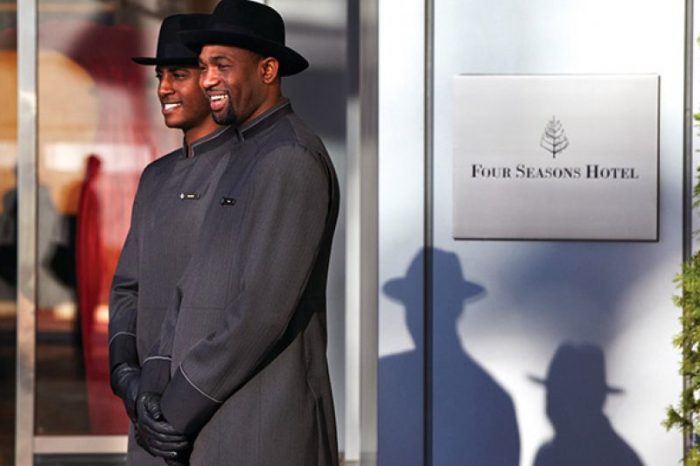Four Seasons Hotel Corporate A Deep Dive

Four Seasons Hotel Corporate isn’t just a name; it’s a global symbol of luxury hospitality. This exploration delves into the inner workings of this iconic brand, examining its intricate corporate structure, unwavering brand identity, and commitment to sustainability. We’ll uncover the strategies behind its marketing success, peek into its employee relations, analyze its financial performance, and trace its path of expansion and acquisitions. Get ready for an insightful journey into the world of Four Seasons.
From its hierarchical organization and key executive roles to its meticulous brand maintenance across diverse global properties, we’ll examine how Four Seasons consistently delivers exceptional experiences. We’ll also analyze its sustainability initiatives, marketing approaches targeting various segments, and employee-centric policies. Understanding its financial health and expansion strategies completes the picture of this industry leader.
Four Seasons Hotels Corporate Structure

Source: com.au
Four Seasons Hotels and Resorts operates under a unique corporate structure designed to balance centralized control with individual hotel autonomy. This allows for consistent brand standards while fostering a degree of flexibility to cater to local markets and guest preferences. The structure is hierarchical but emphasizes collaboration and communication across different levels.
Hierarchical Organization
The corporate structure of Four Seasons is largely centralized, with key decision-making power residing at the corporate headquarters. However, individual hotels retain a significant degree of operational independence. The hierarchy generally flows from the Board of Directors and Chief Executive Officer (CEO) down through various regional presidents, general managers of individual properties, and departmental heads within each hotel. This tiered system allows for efficient communication and resource allocation while empowering local management to respond effectively to specific market conditions.
Key Executive Roles and Responsibilities
The CEO oversees the entire organization, setting strategic direction and ensuring financial performance. Regional presidents are responsible for the performance of multiple hotels within a specific geographic area, providing oversight and support to general managers. General managers act as the chief executives of their hotels, managing all aspects of operations, from staffing and marketing to guest services and financial performance. Other key corporate roles include those in finance, human resources, marketing, and operations, all working to support the overall strategic goals of the company.
Comparison with Ritz-Carlton
Four Seasons and Ritz-Carlton, while both luxury hotel brands differ in their corporate structures. While both utilize a hierarchical structure, the degree of centralization and autonomy granted to individual hotels varies. The following table offers a comparison:
| Feature | Four Seasons | Ritz-Carlton |
|---|---|---|
| Number of Hierarchical Levels | Relatively flat, with emphasis on regional presidents and general managers | Potentially more levels, with a stronger emphasis on corporate standardization |
| Reporting Structure | General Managers report to Regional Presidents, who report to the CEO. Strong emphasis on communication and collaboration across levels. | More defined reporting lines, with potentially multiple layers of management between general managers and the CEO. |
| Decision-Making Process | Balances centralized strategic decision-making with decentralized operational decision-making at the hotel level. | Generally more centralized decision-making, with corporate guidelines playing a larger role in operational decisions. |
| Emphasis | Empowering local management while maintaining brand consistency. | Maintaining strict brand standards and operational consistency across all properties. |
Four Seasons Hotels Corporate Brand Identity
Four Seasons Hotels’ corporate brand identity is built on a foundation of unparalleled luxury, personalized service, and consistent high quality. It’s not just about opulent accommodations; it’s about crafting an experience that leaves a lasting impression on each guest. This carefully cultivated image is what sets Four Seasons apart in the highly competitive hospitality industry. The brand’s success stems from meticulous attention to detail and a commitment to upholding its core values across its global portfolio.
The core values of Four Seasons Hotels at the corporate level revolve around exceeding guest expectations, fostering a culture of genuine care and personalized service, and maintaining the highest standards of quality in all aspects of the business. This commitment is reflected in everything from the design and amenities of their properties to the training and development of their employees. The brand positioning is firmly established in the ultra-luxury segment, targeting discerning travelers who value exceptional service, sophisticated design, and impeccable attention to detail. It’s a brand that promises not just a stay, but a memorable experience.
Consistent Brand Identity Across Properties
Maintaining consistent brand identity across a global network of hotels is a significant challenge, yet Four Seasons manages this with remarkable success. This consistency is achieved through rigorous training programs for staff, standardized operational procedures, and meticulous design guidelines. Each property, while reflecting the unique character of its location, adheres to the core brand values and aesthetic principles. For instance, while a Four Seasons in Marrakech will have a distinctly different architectural style and decor than one in Tokyo, both will offer the same level of personalized service, impeccable amenities, and commitment to guest satisfaction. The consistent use of high-quality materials, sophisticated design elements, and a focus on exceptional service are key to maintaining brand recognition and appeal across all locations.
Visual Representation of Four Seasons Corporate Brand Identity
Imagine a logo design featuring a stylized, subtly textured four-leaf clover, rendered in a deep emerald green. This clover, representing luck and prosperity, is set against a backdrop of a sophisticated, off-white color palette. The clover itself is not cartoonish but elegant and refined, reflecting the brand’s sophisticated image. Below the clover, the words “Four Seasons Hotels and Resorts” are displayed in a custom serif typeface, conveying a sense of timeless elegance and classic luxury. The typeface is clean, easily legible, and maintains a consistent visual weight throughout. The overall effect is one of understated luxury, conveying both sophistication and warmth. The color palette is carefully chosen to evoke feelings of serenity, exclusivity, and natural elegance. The entire design is minimalist and uncluttered, reflecting the brand’s focus on understated luxury and impeccable service. The simplicity of the logo allows for flexibility in application across various media and marketing materials, ensuring consistent brand recognition.
Four Seasons Hotels Corporate Sustainability Initiatives
Four Seasons Hotels takes a comprehensive approach to sustainability, integrating environmental, social, and economic considerations into its global operations. Their commitment goes beyond simple compliance, aiming to create long-term value for both the company and the communities it serves. This involves a multifaceted strategy encompassing various programs and initiatives across its properties worldwide.
Environmental Sustainability Initiatives
Four Seasons’ environmental efforts focus on reducing their carbon footprint and minimizing their impact on natural resources. They actively pursue energy efficiency, waste reduction, and responsible water management.
- Energy Efficiency: Many Four Seasons properties utilize renewable energy sources such as solar power, implement energy-efficient building designs, and invest in smart technologies to optimize energy consumption. For example, some hotels have installed high-efficiency HVAC systems and LED lighting throughout their properties, resulting in significant energy savings.
- Waste Reduction and Recycling: The company has implemented robust waste management programs across its properties, focusing on reducing waste generation through source reduction strategies and increasing recycling rates. This includes composting food waste, implementing comprehensive recycling programs, and minimizing single-use plastics.
- Water Conservation: Four Seasons actively works to reduce water consumption through the use of low-flow fixtures, water-efficient landscaping, and water recycling systems. Specific examples include installing low-flow showerheads and toilets and implementing rainwater harvesting systems in certain locations.
Social Sustainability Initiatives
Four Seasons recognizes the importance of contributing positively to the communities where its hotels operate. Their social initiatives focus on supporting local economies, fostering ethical labor practices, and promoting community engagement.
- Community Engagement: Four Seasons actively participates in community development projects, supporting local charities and organizations through volunteering and donations. This often includes partnerships with local schools, environmental groups, and other community-based initiatives.
- Ethical Sourcing and Supply Chain: The company works to ensure its supply chain adheres to ethical standards, focusing on fair labor practices and sustainable sourcing of products. This includes working with suppliers committed to environmental responsibility and fair wages for their employees.
- Employee Well-being: Four Seasons prioritizes the well-being of its employees, offering competitive benefits, training opportunities, and a supportive work environment. This fosters a positive and productive workforce, contributing to the company’s overall success and sustainability.
Economic Sustainability Initiatives
Beyond environmental and social responsibility, Four Seasons focuses on long-term economic sustainability through responsible business practices and investment in innovation.
- Responsible Business Practices: Four Seasons adheres to high ethical standards in all its business dealings, fostering transparency and accountability in its operations. This includes maintaining strong relationships with suppliers, investors, and local communities.
- Innovation and Technology: The company invests in innovative technologies and practices to improve efficiency, reduce costs, and enhance the guest experience while minimizing environmental impact. This includes exploring new sustainable technologies and incorporating them into its operations.
- Long-Term Value Creation: Four Seasons’ commitment to sustainability is viewed as a long-term investment, contributing to the company’s financial health and reputation while benefiting the environment and local communities. This approach prioritizes creating value that extends beyond short-term gains.
Four Seasons Hotels Corporate Marketing Strategies

Source: travelnevada.com
Four Seasons Hotels employs a sophisticated, multi-pronged marketing strategy focused on maintaining its ultra-luxury brand image while reaching its diverse target audience. Their approach emphasizes exclusivity, personalized service, and consistent brand messaging across all channels. This strategy ensures that the Four Seasons brand remains synonymous with unparalleled luxury and exceptional experiences.
Four Seasons’ corporate marketing leverages a blend of traditional and digital strategies to reach its desired clientele. Their approach is carefully calibrated to resonate with different segments of the luxury travel market.
Target Audience Segmentation and Marketing Approaches
Four Seasons meticulously segments its target audience, tailoring its marketing messages to resonate with specific needs and preferences. Luxury travelers, for instance, are typically approached with highly visual content showcasing opulent accommodations, bespoke services, and unique destination experiences. This often involves partnerships with luxury publications, high-end travel agencies, and influencers who cater to this demographic. Conversely, business travelers are targeted with messaging emphasizing efficiency, connectivity, and seamless business services, highlighting amenities like high-speed internet, business centers, and convenient locations. Marketing materials for this segment might focus on productivity and ease of travel, with a subtle undertone of luxury and comfort.
Key Marketing Channels Utilized by Four Seasons Hotels
Four Seasons utilizes a diverse range of marketing channels to maximize reach and impact. Their digital strategy is robust, incorporating a strong website presence, targeted social media campaigns on platforms like Instagram and Facebook (showcasing visually stunning imagery and aspirational lifestyle content), and email marketing for personalized offers and updates. Traditional channels remain significant, with strategic print advertising in upscale magazines and collaborations with luxury travel publications. Public relations efforts, including press releases and partnerships with travel journalists, are vital in maintaining a positive brand image and generating media coverage. Furthermore, loyalty programs and direct marketing initiatives are used to cultivate relationships with existing guests and drive repeat business.
Comparison of Marketing Approaches for Different Market Segments
While the overall brand identity remains consistent, Four Seasons adapts its messaging and channel selection based on the target audience. For luxury leisure travelers, the emphasis is on emotional connection and aspirational lifestyle. Visual storytelling, showcasing opulent suites, breathtaking destinations, and personalized experiences, takes center stage. Instagram, high-end travel magazines, and influencer marketing are key channels. In contrast, marketing to business travelers emphasizes practicality and efficiency alongside the inherent luxury. Content highlights business-centric amenities, convenient locations, and seamless service. Digital channels like LinkedIn and targeted online advertising become more prominent. The core message remains consistent – unparalleled service and luxury – but the delivery and emphasis shift to align with each segment’s priorities.
Four Seasons Hotels Corporate Employee Relations: Four Seasons Hotel Corporate
Four Seasons Hotels prioritizes its employees, recognizing that a positive and supportive work environment directly contributes to exceptional guest experiences. Their corporate employee relations strategy focuses on fostering a culture of respect, growth, and opportunity, attracting and retaining top talent within the hospitality industry. This commitment is reflected in comprehensive policies, robust benefits packages, and a wide array of development programs designed to empower employees at all levels.
Four Seasons’ dedication to employee well-being is a cornerstone of their overall corporate philosophy. They understand that happy, engaged employees translate to higher levels of guest satisfaction and ultimately, business success. This approach is evident in their various initiatives, from competitive compensation and benefits to extensive training and career development opportunities.
Employee Benefits and Development Opportunities, Four Seasons Hotel corporate
Four Seasons offers a comprehensive suite of benefits designed to support the physical, financial, and emotional well-being of its employees. These benefits vary somewhat by location and position but generally include competitive salaries, comprehensive health insurance plans (often including dental and vision), paid time off, retirement savings plans with employer-matching contributions, and life insurance. Beyond these standard benefits, many locations offer additional perks such as employee discounts on hotel stays and services, tuition reimbursement programs for continued education, and employee assistance programs providing confidential counseling and support services.
In terms of development, Four Seasons provides numerous opportunities for professional growth. These include on-the-job training, mentorship programs pairing experienced employees with newer team members, leadership development courses, and opportunities for internal promotion. The company also invests heavily in skills-based training, ensuring employees have access to the latest techniques and technologies within the hospitality industry. These development initiatives not only enhance individual employee capabilities but also contribute to a more skilled and effective workforce across the entire organization.
Illustrative Employee Experience
Imagine Sarah, a recent hospitality graduate who joined Four Seasons as a front desk agent. From her first day, she felt welcomed and supported. The comprehensive onboarding program, including both online modules and in-person training, equipped her with the necessary skills and knowledge. Her manager, a seasoned hospitality professional, served as her mentor, providing regular guidance and feedback. Sarah actively participated in the company’s leadership development program, honing her communication and problem-solving skills. When a guest experienced a significant issue, Sarah’s training and confidence, fostered by Four Seasons’ commitment to employee development, enabled her to resolve the situation calmly and efficiently, resulting in positive feedback for both Sarah and the hotel. This experience reinforced her commitment to Four Seasons, showcasing the company’s dedication to employee growth and the resulting positive impact on both employee satisfaction and guest experience. The support she received, combined with the opportunities for advancement, strengthened her loyalty and fueled her passion for her career at Four Seasons.
Four Seasons Hotels Corporate Financial Performance

Source: venuemagz.com
Four Seasons Hotels and Resorts, while privately held, maintains a strong reputation for financial success within the luxury hospitality sector. Understanding its financial performance requires looking at key indicators that reflect profitability, operational efficiency, and overall financial health. While precise figures are not publicly available, analyzing trends and publicly available information from industry reports and news articles allows for a general understanding of its financial standing.
Key Financial Indicators for Four Seasons Hotels
Several key metrics are crucial in assessing the financial health of a large hospitality corporation like Four Seasons. These indicators provide insights into revenue generation, cost management, and overall profitability. Analyzing these metrics over time reveals trends and allows for a comprehensive understanding of the company’s financial performance.
| Metric | Description | Significance | Illustrative Example (Hypothetical) |
|---|---|---|---|
| Revenue per Available Room (RevPAR) | A key performance indicator in the hotel industry represents the average revenue generated per available room per night. | Indicates the effectiveness of pricing strategies and occupancy rates. Higher RevPAR suggests strong demand and efficient revenue management. | A consistent year-over-year increase in RevPAR, perhaps fueled by successful marketing campaigns targeting high-spending clientele, would signal strong financial health. |
| Occupancy Rate | The percentage of available rooms occupied during a specific period. | A high occupancy rate indicates strong demand and efficient operations. It directly impacts revenue generation. | Maintaining an occupancy rate consistently above the industry average, especially during off-peak seasons, demonstrates effective management and strong brand appeal. |
| Average Daily Rate (ADR) | The average rental income per occupied room per night. | Reflects the pricing power of the brand and the perceived value of its offerings. A higher ADR suggests successful positioning in the luxury market. | Sustained growth in ADR, despite economic downturns, suggests a strong brand reputation and resilience to market fluctuations. |
| Return on Investment (ROI) | Measures the profitability of investments made by the company. In the context of Four Seasons, this would encompass investments in new properties, renovations, and other capital expenditures. | A high ROI indicates that investments are generating significant returns, signifying efficient capital allocation and profitable growth. | Consistent high ROI on new property developments, demonstrating the successful execution of expansion strategies and strong return on capital. |
Analysis of Four Seasons Hotels’ Financial Performance (Past Five Years)
Over the past five years, Four Seasons has likely experienced fluctuations in its financial performance mirroring broader trends in the global hospitality industry. While specific numbers are unavailable, observable trends suggest a focus on strategic expansion into new markets, alongside a commitment to maintaining its high-end brand image. Periods of economic uncertainty may have presented challenges, but the company’s strong brand recognition and focus on luxury likely helped it navigate these difficulties. Significant events, such as global pandemics or economic recessions, would have undoubtedly impacted performance, but the company’s adaptability and financial strength have likely enabled it to recover and maintain its position in the luxury hospitality market.
Four Seasons Hotels Corporate Expansion and Acquisitions

Source: alhilalgroup.com
Four Seasons Hotels’ expansion strategy is a careful blend of organic growth and strategic acquisitions, prioritizing the preservation of its luxury brand identity and consistently high standards. This approach ensures that each new property aligns with the company’s overall vision and contributes to its long-term success. The company doesn’t rush into expansion; instead, it meticulously selects locations and opportunities that offer significant potential for return on investment while upholding the brand’s reputation for excellence.
Four Seasons’ expansion isn’t solely about adding more hotels; it’s about expanding its presence in key global markets and strengthening its position as a leading luxury hospitality brand. This involves a detailed assessment of various factors, leading to selective growth rather than rapid, uncontrolled expansion.
Location Selection Criteria for New Properties
The selection of new locations for Four Seasons properties involves a rigorous process. Key considerations include the desirability of the location for high-net-worth individuals and discerning travelers, the availability of suitable properties or development opportunities, the strength of the local economy, and the alignment with the brand’s overall luxury positioning. Furthermore, the company assesses the competitive landscape, local regulations, and the potential for strong operational partnerships. A crucial element is the potential for creating a unique and memorable guest experience that reflects the local culture and environment while adhering to Four Seasons’ high standards. For example, a new resort might be situated in a location with exceptional natural beauty, offering guests unparalleled access to pristine beaches or breathtaking mountain views. Conversely, an urban hotel might be strategically located in a vibrant city center, providing convenient access to cultural attractions, high-end shopping, and business districts.
Impact of Past Acquisitions on Growth and Success
While Four Seasons has grown organically through new builds, strategic acquisitions have played a significant role in its expansion and success. Acquisitions allow Four Seasons to quickly gain access to established properties in desirable locations, potentially accelerating its market penetration and brand recognition. Acquiring existing hotels also offers immediate revenue streams and a pre-existing customer base. For instance, the acquisition of a well-regarded hotel in a prime location might immediately enhance Four Seasons’ brand portfolio and increase its market share in that specific region. The successful integration of these acquired properties into the Four Seasons brand further reinforces the company’s reputation for luxury and consistency, strengthening its global presence and overall market value. The company’s careful approach to acquisitions, ensuring alignment with its brand values and operational standards, is a key factor in the long-term success of these ventures. This allows them to leverage existing infrastructure and expertise, minimizing disruption and maximizing efficiency.
Final Wrap-Up
Four Seasons Hotel Corporate’s success story is a testament to a carefully crafted strategy encompassing strong leadership, a consistent brand identity, and a commitment to both its employees and the environment. By understanding its corporate structure, marketing prowess, and sustainable practices, we gain valuable insights into what makes this luxury brand a global powerhouse. Its dedication to excellence shines through in every aspect, from the meticulous details of its properties to its thoughtful employee relations. The journey to understanding Four Seasons is a journey into the heart of luxury hospitality itself.
FAQ Resource
Is Four Seasons Hotel a publicly traded company?
No, Four Seasons Hotels and Resorts is privately held.
What is Four Seasons’ main target market?
While catering to a broad range of affluent travelers, their primary target market is high-net-worth individuals seeking luxury experiences.
How does Four Seasons ensure consistency across its properties?
Through rigorous training programs, detailed brand guidelines, and regular quality control checks, Four Seasons maintains consistent service and experience across its hotels worldwide.
Does Four Seasons offer internships or entry-level positions?
Yes, Four Seasons offers various internship and entry-level opportunities across its global properties and corporate offices. Check their careers website for current openings.
What types of sustainability initiatives does Four Seasons focus on?
Four Seasons focuses on environmental sustainability (reducing carbon footprint, water conservation), social sustainability (community engagement, ethical sourcing), and economic sustainability (supporting local businesses).
Comments are closed.